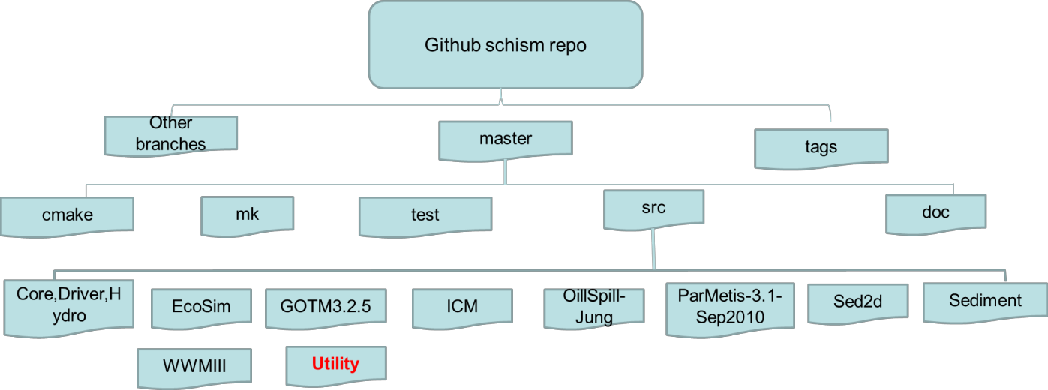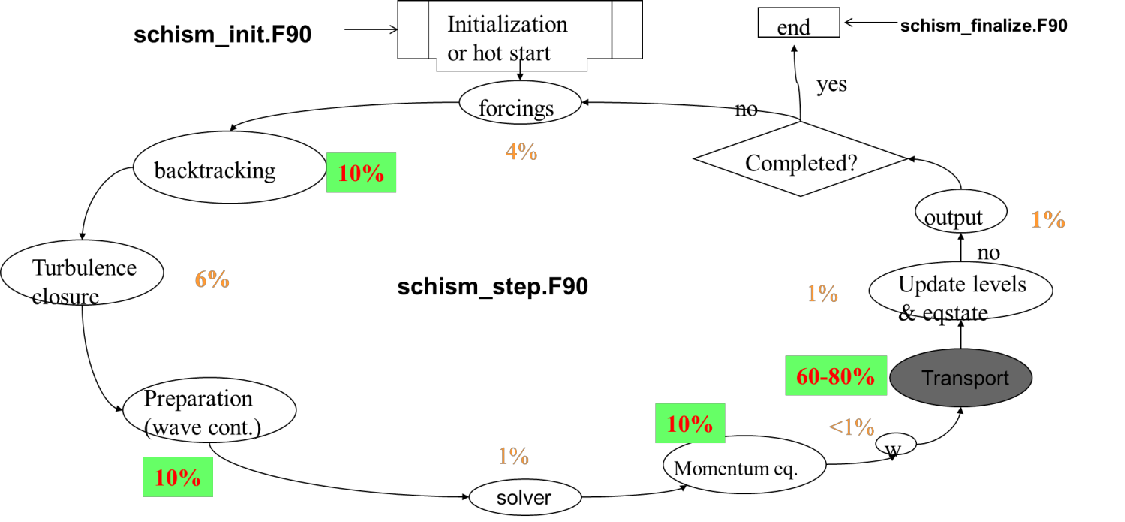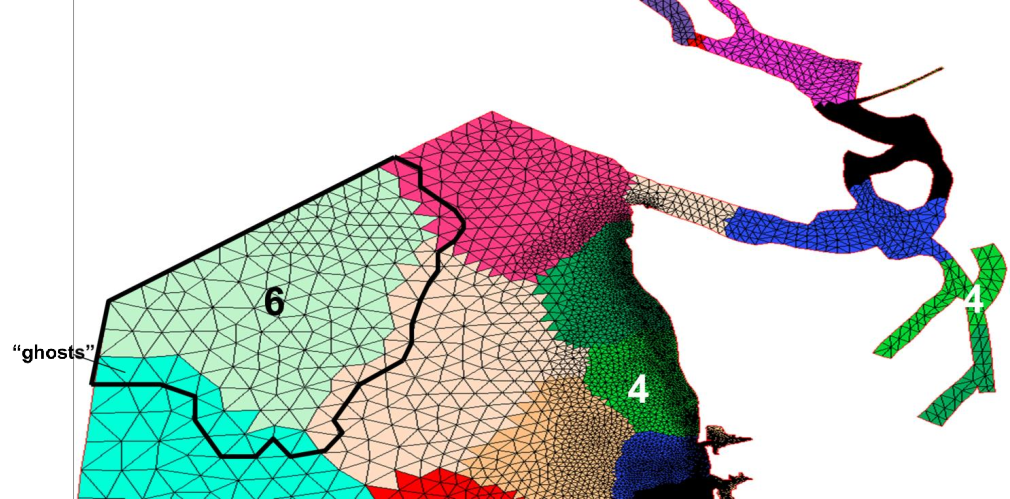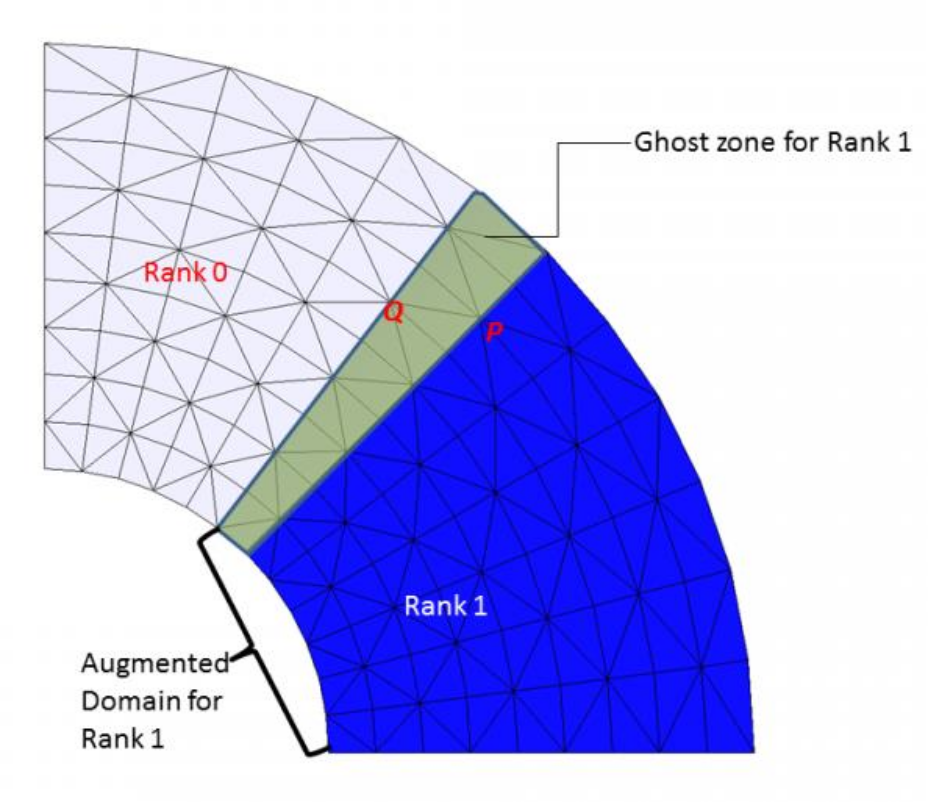Code structure
The information presented in this chapter is mostly intended for developers or anyone who wishes to work on the code. To know more about how to contribute your code see CONTRIBUTING.md on SCHISM github repo.
General info¶
SCHISM was written in MPI FORTRAN 90. After svn revision 5225, we have migrated to github. Figure 1 shows the directory structure of the SCHISM github repository schism. General public have access to all branches.

Figure 2 shows its main work flow and major code blocks. Two files inside src/ (Hydro/schism_init.F90 and Hydro/schism_step.F90) represent bulk of the hydro code, and are driven by a master program (Driver/schism_driver.F90). The global variables are defined in Core/schism_glbl.F90, and the message passing routines are defined in Core/schism_msgp.F90.

The domain decomposition is done using ParMETIS graph partitioning library (included in the src/). Figure 3 shows an example of sub-domains generated by this lib.

The Utility dir has a lot of useful utility scripts for pre- and post-processing. The header of each program generally has info on its purpose and instructions on how to use it.
ACE: source code and install notes for ACE tools; the manual can be found on Forum.Combining_Scripts: FORTRAN and perl scripts used to gather outputs from SCHISM (e.g.,outputs/schout_0*_[stack number].ncetc) into one binary file (schout_[stack_number].nc).Grid_Scripts: FORTRAN codes to interpolate depths from DEM files in either structured grid (raster) or unstructured grid format. While ACE/xmgredit5 can do similar things, these scripts are mostly for interpolating from very large DEM files.Gen_Hotstart: scripts for preparinghotstart.ncfrom e.g., netcdf outputs from a structured-grid model.Pre-Processing: various scripts for pre-processing (checking, viz etc)OneWayNestScripts: scripts for 1-way nesting, by preparing*[23]D.th.nc(elevation, horizontal velocity, salinity and temperature boundary condition) that can be used for the 'small-domain' run.Particle_Tracking: particle tracking code that uses SCHISM's outputs for 3D tracking.Post-Processing-Fortran: FORTRAN codes for extracting time series at selected 3D points (including transects). You can modify these codes for your own purposes.Sflux_nc: matlab scripts useful for preparing your own .nc files forsflux/.NARR_util/has scripts to prepare .nc files from NCEP's NARR products.SMS: scripts to convert between.2dmof SMS and.gr3.Vis_Matlab: matlab scripts for viz. At the moment, these scripts have not been updated to handle \(LSC^2\) grid.
Domain partitioning¶
The domain is first portioned into non-overlapping sub-domains (in element sense; see Figure 3) using ParMETIS. Then each sub-domain is augmented with 1 layer of ghost elements. This is accomplished by the call partition_hgrid() early in the main program. After calling aquire_hgrid(.true.) immediately after that, the elements, nodes, sides in each augmented and non-augmented (i.e., without ghosts) domains are shown in Figure 3. The corresponding variable denoting number of Elements, Nodes, and Sides are given in the following table. Intuition is typically followed although there are exceptions as will be described below.
| Global | Local non-augmented | Ghost | Augmented | |
|---|---|---|---|---|
| Elements | ne_global |
ne |
neg |
nea=ne+neg |
| Nodes | np_global |
np |
npg |
npa=np+npg |
| Sides | ns_global |
ns |
nsg |
nsa=ns+nsg |
The call to ParMETIS routine is as follows -
call ParMETIS_V3_PartGeomKway(vtxdist,xadj,adjncy,vwgt,adjwgt,wgtflag, &
numflag,ndims,xyz,ncon,nproc,tpwgts,ubvec,options, &
edgecut,part,comm)
p: # of processors;n: total # of vertices (local) in graph sense;m: total # of neighboring vertices ("edges"); double counted between neighboring vertice u and v.ncon: # of weights for each vertex.int(in) vtxdist(p+1): Processorjstores verticesvtxdist(j):vtxdist(j+1)-1int (in) xadj(n+1), adjncy(m): locally, vertexj's neighboring vertices areadjncy(xadj(j):xadj(j+1)-1). adjncy points to global index;int(in) vwgt(ncon*n), adjwgt(m): weights at vertices and "edges". Format of adjwgt follows adjncy;int(in) wgtflag:0: none (vwgtandadjwgtare NULL);1: edges (vwgtisNULL);2:vertices (adjwgtisNULL);3: both vertices & edges;
int(in) numflag:0: C-style numbering from 0;1: FORTRAN style from 1;
int(in) ndims: 2 or 3 (D);float(in) xyz(ndims*n): coordinate for vertexjisxyz(j*ndims:(j+1)*ndims-1)(C style);ndims*(j-1)+1: ndims*j(FORTRAN style);int(in) nparts: # of desired sub-domains (usuallynproc);float(in) tpwgts(ncon*nparts):=1/npartsif sub-domains are to be of same size for each vertex weight;float(in) ubvec(ncon): imbalance tolerance for each weight;int(in) options: additonal parameters for the routine (see above);int(out) edgecut: # of edges that are cut by the partitioning;int(out) part(): array size = # of local vertices. It stores indices of local vertices.
Arrays and constant¶
llist_type :: iegl(iegb):iegbis a global element #. If the element is resident (not ghost),iegl(iegb)%rank=myrank, andiegl(iegb)%id = local element index, andiegl%next=null. Ifiegbis a ghost, theniegllist has two entries:myrankand the rank whereiegbis resident. All processors have this info, but the lists are different (1st entry is usually myrank etc).llist_type :: ipgl(ipgb):ipgbis a global node #. Use this list only when the node is resident (not ghost); it’s confusing whenipgbis ghost. Ifipgbis resident,ipgl(ipgb)%rank=myrank, andipgl(ipgb)%id = local node index.ipgl%next%next%next....is the linked list, with ranks in ascending order. Unlessipgbis an interface node (i.e., resident in more than 1 process), the list has only 1 entry. All processors have this info, but the lists are different (1st entry is usually myrank etc).llist_type :: isgl(isgb):isgbis a global side #. Similar toipgl, if the side is resident (not ghost),isgl(isgb)%rank=myrank, andisgl(isgb)%id = local side index.isgl%next%next...is the list, with ranks in ascending order. All processors have this info, but the lists are different (1st entry is usually myrank etc).int :: ielg(ie), iplg(ip), islg(isd): The global element index of local element ie in the augmented domain. Similar for the other two (nodes/sides).int :: iegrpv(iegb): The rank # for global elementiegb(before augmenting the domain). Used mainly in partitioning the grid.- Arrays that have similar meaning between global and local aug. domains, i.e., they do not have problem of getting outside the aug. domain:
i34,elnode(old name:nm),elside(js),ssign,snx,sny. - Arrays that need special attention in the aug. domain -
int :: ic3(1:i34(), ie)–positiveif the neighbor element is inside the aug. domain as well (and in this case it is the local index of the neighbor element);0if (global) boundary;negativeif the neighbor element is outside the aug. domain and in this case, the absolute value is the global element index.int :: nne(ip)– total # of neighbor elements around local nodeip, including those outside the aug. domain (i.e., same asnnegb()).int :: indel(1: nne(ip),ip)– surrounding element indices. If inside aug. domain, this is the local element index; if outside, this is the negative of the global element index.int :: iself(1: nne(ip),ip)– same as globaliselfgb, i.e., the elemental local index for nodeipin neighbor elementindel()(even if it is outside).int :: nnp(ip)– total # of surrounding nodes for nodeip, excluding all nodes outside the aug. domain. For SCHISM, include all nodes outside.int :: indnd(1: nnp(ip),ip)– list of surrounding nodes, excluding all nodes outside the aug. domain. For SCHISM, all nodes outside will have negative global index returned.int :: isdel(1:2,isd)&isidenode(1:2,isd)– order of the two adjacent elements follows global indices, and so the vector from node 1 to 2 inisidenode(1:2,isd)forms local y-axis while the vector from element 1 to 2 in isdel(1:2,isd) forms local x-axis. Therefore either ofisdel(1:2,isd)can be negative. The element index is local (positive) if it is inside the aug. domain; otherwise the minus of global element index is returned. The local sideisdis on the boundary if and only ifisdel(2,isd)=0, and in this case,isdel(1,isd)must be inside the aug. domain (i.e., positive) (ifisdis resident). Ifisdis resident and not ghost,isdel()has the same meaning as serial code, i.e.,is(1,isd)>0(inside the aug. domain), andisdel(2,isd)>=0, andisdis on the boundary if and only ifisdel(2,isd)=0.double :: delj(isd)– meaningful only if isd is resident.
- Boundary arrays : Most arrays point to global bnd segment #. Most B.C. arrays are global as well.
nope_global– total # of open bnd segements in the global domain.nope– total # of open bnd segements in the aug. domain.iopelg(1:nope)– returns global open bnd segment # for a local open bnd segment.iopegl(0,k)- # of local fragmentations of global open bnd segment k.iopegl(j,k)- local segment # of jth (1<=j<=iopegl(0,k)) fragmentation of global open bnd segment k.nond(1:nope)– total # of open bnd nodes on each segment. The corresponding global array isnond_global().iond(nope,1: nond(1:nope))– list of local node indices on each open bnd segment. The corresponding global array isiond_global().nland- total # of land bnd segements in the aug. domain.nland_globalis global.nlnd(1:nland)- total # of land bnd nodes on each segment.ilnd(nland,1: nlnd(1:nland))– list of local node indices on each land bnd segment.nosd(nope)(ELCIRC) - # of open bnd sides on each segment.iosd(nope, 1: nosd(nope))(ELCIRC) – list of open bnd side on each segment.noe(nope)(ELCIRC) - # of open bnd elements on each segment.ioe(nope, 1: noe(nope))(ELCIRC) – list of open bnd elements on each segment.isbe(2,1:nea)(ELCIRC) – if the element is on the local open bnd, this returns the local segment # and element #. 0 otherwise.isbs()(ELCIRC) – similar toisbe.isbnd(-2:2,ip)(SCHISM) - Ifipis on 1 open bnd only,isbnd(1,ip)points to the global segment # of that open bnd andisbnd(2,ip)=0; ifipis on 2 open bnds,isbnd(1:2,ip)point to the global segment #s for the 2 open bnds. Ifipis on land bnd only (i.e., not on open bnd),isbnd(1,ip)= 1andisbnd(2,ip)=0. Ifipis an internal node,isbnd(1:2,ip)=0. Therefore,ipis on open bnd ifisbnd(1,ip)>0(and in this caseisbnd(2,ip)may also be positive, even thoughisbnd(2,ip)may be outside the aug. domain), on land bnd (not on any open bnd) ifisbnd(1,ip)= 1, and an internal node ifisbnd(1,ip)=0. If on open bnd,isbnd(-2:-1,ip)are global index (i.e.,isbnd(-1,ip)th node on theisbnd(1,ip)th open bnd);isbs(nsa)- positive if a local side is on the global open bnd (in this case,isbs()is the global segment #); 1 if it is on land bnd; 0 if internal side.iettype,ifltype,itetype, andisatypeall take global bnd segment as argument; other b.c. arrays (ethetc) are also global.uth(nvrt,nsa),vth(nvrt,nsa)– local b.c. forifltype/=0for a local side.uthnd(nvrt,mnond_global, nope_global),vthnd()– global arrays.elbc(ip)–ipis a local node.
- Arrays defined in
elfe_msgp.F90nnbr- # of neighbor processors (excludingmyrank).nbrrank(nnbr)– rank of each neighbor processor.int :: ranknbr(0:nproc-1)– neighbor # for each processor (0 if not neighbor).nerecv(nnbr)- # of elements to be received from each neighbor.ierecv(1: nerecv(nnbr),nnbr)– list of element indices (ghost inmyrank) to be received from each neighbor (where the elements are resident and not ghost).nesend(nnbr)- # of elements to be sent to each neighbor.iesend(1: nesend(nnbr),nnbr)– list of element indices (local resident inmyrank) to be sent to each neighbor (where the elements are ghost). Similar for nodes/side (nprecv,iprecvetc).
A note on ghost exchange
Since the message exchanges between processors have to wait for each other in order to communicate collectively, it's not necessary to synchronize the processes.
Important MPI routines¶
MPI_Recv
int MPI_Recv(
void *buf,
int count,
MPI_Datatype datatype,
int source,
int tag,
MPI_Comm comm,
MPI_Status *status )
!Inputs:
! count - maximum number of elements in receive buffer (integer);
! datatype - datatype of each receive buffer element (handle);
! source - rank of source (integer);
! tag - message tag (integer);
! comm - communicator (handle).
!Outputs:
! buf - initial address of receive buffer (choice);
! status - status object (Status).
MPI_Irecv: nonblock receive.
int MPI_Irecv(
void *buf,
int count,
MPI_Datatype datatype,
int source,
int tag,
MPI_Comm comm,
MPI_Request *request )
!Inputs:
! buf - initial address of receive buffer (choice);
! count - number of elements in receive buffer (integer);
! datatype - datatype of each receive buffer element (handle);
! source - rank of source (integer);
! Tag - message tag (integer);
! comm - communicator (handle).
!Output:
! request - communication request (handle)
MPI_Send
int MPI_Send(
void *buf,
int count,
MPI_Datatype datatype,
int dest,
int tag,
MPI_Comm comm )
!Inputs:
! buf - initial address of send buffer (choice);
! count - number of elements in send buffer (nonnegative integer);
! datatype - datatype of each send buffer element (handle);
! dest - rank of destination (integer);
! tag - message tag (integer);
! comm - communicator (handle).
MPI_Isend: non-block send
int MPI_Isend(
void *buf,
int count,
MPI_Datatype datatype,
int dest,
int tag,
MPI_Comm comm,
MPI_Request *request )
! Inputs:
! buf - initial address of send buffer (choice);
! count - number of elements in send buffer (integer);
! datatype - datatype of each send buffer element (handle);
! dest - rank of destination (integer);
! tag - message tag (integer);
! comm - communicator (handle).
!Output:
! request - communication request (handle).
MPI_Allreduce: Combines values from all processes and distribute the result back to all processes
int MPI_Allreduce (
void *sendbuf,
void *recvbuf,
int count,
MPI_Datatype datatype,
MPI_Op op,
MPI_Comm comm )
! Inputs:
! sendbuf - starting address of send buffer (choice);
! count - number of elements in send buffer (integer). Also the size of the output
! (i.e., ith elements from each processor are summed up and returned as ith element of output);
! datatype - data type of elements of send buffer (handle);
! op - operation (handle) (e.g., MPI_SUM, MPI_LOR);
! comm - communicator (handle).
! Output:
! recvbuf - starting address of receive buffer (choice).
MPI_Reduce
int MPI_Reduce (
void *sendbuf,
void *recvbuf,
int count,
MPI_Datatype datatype,
MPI_Op op,
int root,
MPI_Comm comm )
! only difference from MPI_Allreduce is that the result is sent to rank "root".
MPI_Gather: Gathers together values from a group of processes.
int MPI_Gather (
void *sendbuf,
int sendcnt,
MPI_Datatype sendtype,
void *recvbuf,
int recvcount,
MPI_Datatype recvtype,
int root,
MPI_Comm comm )
! Inputs:
! sendbuf - starting address of send buffer (choice)
! sendcount - number of elements in send buffer (integer)
! sendtype - data type of send buffer elements (handle)
! recvcount - number of elements for any single receive (integer, significant ! only at root)
! recvtype - data type of recv buffer elements (significant only at root) (handle)
! root - rank of receiving process (integer)
! comm - communicator (handle)
! Output:
! Recvbuf - address of receive buffer (choice, significant only at root). The received values
! are stacked according to the rank number (i.e., first recvcount are from rank 0 etc).
MPI_Allgatherv: Gathers data from all tasks and deliver it to all.
int MPI_Allgatherv (
void *sendbuf,
int sendcount,
MPI_Datatype sendtype,
void *recvbuf,
int *recvcounts,
int *displs,
MPI_Datatype recvtype,
MPI_Comm comm )
!Inputs:
! sendbuf - starting address of send buffer (choice);
! sendcount - number of elements in send buffer (integer)
! sendtype - data type of send buffer elements (handle);
! recvcounts - integer array (of length group size) containing the number of elements
! that are received from each process;
! displs - integer array (of length group size). Entry i specifies the displacement
! (relative to recvbuf) at which to place the incoming data from process i;
! recvtype - data type of receive buffer elements (handle);
! comm. - communicator (handle).
! Output:
! recvbuf - address of receive buffer (choice).
MPI_Type_indexed: Creates an indexed datatype; the corresponding routine inMPI2 is mpi_type_create_indexed_block().
int MPI_Type_indexed(
int count,
int blocklens[],
int indices[],
MPI_Datatype old_type,
MPI_Datatype *newtype )
! Inputs:
! count - number of blocks -- also number of entries in indices and blocklens;
! blocklens - number of elements in each block (array of nonnegative integers);
! indices - displacement of each block in multiples of old_type (array of integers);
! old_type - old datatype (handle).
! Output:
! newtype - new datatype (handle)
Note
The new MPI type treats multi-dimensional arrays in FORTRAN as 1D array, expanding with 1st index varying before 2nd etc. So this routine can be used to grab discontiguous data blocks from multi- dimensional arrays. So if a 2D array is a(nvrt,nea) the corresponding 1D array is illustrated below:
Now suppose we need to grab all ghost elements iesend(1:nesend), these will correspond to rows iesend(i) of the table. In this case the # of blocks is nesend, block length is nvrt, and displacement of ith block is (iesend(i)-1)*nvrt.
MPI_Barrier: Blocks until all process have reached this routine.
MPI_Type_struct: Creates a struct datatype.
int MPI_Type_struct(
int count,
int blocklens[],
MPI_Aint indices[],
MPI_Datatype old_types[],
MPI_Datatype *newtype )
! Inputs:
! count - number of blocks (integer)
! also number of entries in arrays array_of_types, array_of_displacements and array_of_blocklengths;
! blocklens - number of elements in each block (array);
! indices – byte displacement of each block relative to the start of the type (array);
! old_types - type of elements in each block (array of handles to datatype objects).
! Output:
! newtype - new datatype (handle)
MPI_Alltoall: Sends data from all to all processes.
int MPI_Alltoall(
void *sendbuf,
int sendcount,
MPI_Datatype sendtype,
void *recvbuf,
int recvcnt,
MPI_Datatype recvtype,
MPI_Comm comm )
! Inputs:
! sendbuf - starting address of send buffer (choice);
! sendcount - number of elements to send to each process (integer);
! sendtype - data type of send buffer elements (handle);
! recvcount- number of elements received from any process (integer);
! recvtype - data type of receive buffer elements (handle);
! comm. - communicator (handle).
! Outputs
! recvbuf - address of receive buffer (choice)
I/O channels in SCHISM¶
You need to exercise caution when dealing with parallel I/O especially for writing. For writing outputs, you’d generally let only 1 process do the job, e.g.
If you do need to have all processes write e.g. debug messages, you’d consider using channel 12 which has been pre-set to point to multiple files from each MPI process (see below).
Here are all I/O channel numbers currently used in different sub-models of SCHISM (and so you’d avoid using them). A good way to find out if a channel is available is to issue the following cmd from src/ -
Please contact lead developer after you have selected a channel number to use in your module.
-
Hydro/: Channels between 8 and 200 are used by various codes for I/O. In particular -- 101 to 100+noutputs (inclusive of both): reserved for global outputs (including from tracers like sediment, EcoSim, ICM, as well as WWM);
- 201-250: non-standard outputs (e.g. at sidecenters, prism centers);
- 251 to 259: reserved for station outputs;
- 16: this channel points to mirror.out (on rank 0), the main message output about the run. You should use it with
if(myrank==0).
-
WWM- 1100 to 1200: handles for inputs/outputs etc
-
EcoSim- 600: outputting some messages
-
ICM- 301 to 323: reading channels for non-point source inputs for ICM
-
Sediment (SED and SED2D)- 26, 2626
Following are some generic channels -
10, 31, 32: used for one-off I/O – can be used by other sub-models as long as you close them immediately after use;12: this channel is initialized by different processes to point to filesoutputs/nonfatal_xxxx, where “xxxx” are the process IDs. Therefore it’s very useful for debugging purpose; you can use it anywhere in your part of the code to dump messages to these files.
Example code¶
If you are working on the code you may be confused about the exchanges inside SCHISM. When should you use these?
The first thing you need to remember when writing MPI code with domain decomposition is that a rank (or MPI 'process') only has info in its 'augmented' (=resident + ghost) domain, and knows absolutely nothing outside this region.

Consider Figure 4. For example, you want to do averaging at each node of the sub-domain around its ball of elements.
do i=1,np !not 'npa'
sum1=0
sum_a=0
do j=1,nne(i)
ie=indel(j,i)
sum1=sum1+stokes(ie)*area(ie)
sum_a=sum_a+area(ie)
enddo !j
stokes_nd(i)=sum1/sum_a
enddo !i
call exchange_p2d(stokes_nd)
Notice that you'd use np instead of npa (=np+npg; augmented domain) here. For any resident node P, indel() is well defined (because again, Rank 1 has info in its augmented domain including the ghost zone), and so the loops make sense. As long as all ranks have same info in each others' ghost zones (which is the purpose of exchange routines), stokes_nd at an interface
node (e.g. P) will be same across ranks. However, for a ghost node Q, some surrounding elements are located outside the augmented domain (and in this case, indel() are actually negative!), and so if you use the same operation, erroneous values at ghost nodes would be generated. Therefore you cannot use npa in the outer loop.
Now, after this loop is executed, what happens to the ghost nodes like Q? Since they are excluded on Rank 1, the stokes_nd will be wrong there. Fortunately, some neighboring ranks have the correct values for these nodes, which are resident nodes in those neighboring ranks; e.g., Q is a resident node of Rank 0. So now different ranks will have different values at some overlapping nodes, and this needs to be avoided. In order to make sure each rank has correct (and up-to-date) values in its augmented domain, you need to follow this loop with an exchange routine. Remember that for the exchange routines to work, you need to define the exchanged array in the augmented domain -
in order to allow each rank to receive info in the ghost zone. Description of all exchange routines used in SCHISM can be found in schism_msgp.F90.
The above is just one example of when exchanges are needed. Usually this involves some kind of queries into a neighborhood, but beware that there are other circumstances where exchanges are necessary.
The most important thing to remember
- A rank only has info in its 'augmented' domain, and knows absolutely nothing outside this region.
- In MPI code, it's crucial to make sure all ranks have identical values in overlapping zone.
Now let's consider an example where no exchanges are needed. Say you want to simply go through all elements and update some arrays defined at elements:
Since all ranks have info of cde and area locally available, qdl_e will be correctly calculated even inside the ghost zones, and its values are the same cross ranks there (since cde and area are same cross ranks in the overlapping zones). So in this case you'd use nea instead of ne in the loop. Of course, there is nothing wrong with using ne in the loop followed by an exchange routine, but doing so would be less efficient and incur unnecessary communication cost.
General code guide¶
Here are some house rules for preparing your own code -
- No spaces between
#(pre-processor) andif/else/endfor CPP flag; - Try to use the I/O channel number directly, e.g.,
read(61, etc)instead of assigning a number to a variable (e.g.read(ich,). This'd facilitate others searching for conflicts; - Avoid using tabs in editor as they mess up with the appearance. Use space instead and strictly align code blocks for easy read.
- Do not use automatic arrays of ≥2 dimensions. It’s often tempting to grab dimensions directly from the module
schism_glbland use them to define arrays in a routine; e.g.vel_sd(nvrt,nsa). This causes trouble with some compilers and may result in segfault. Use either of the following 2 approaches instead:- allocatable arrays (and always remember to deallocate them at the end of the routine);
- pass on the dimensions explicitly as dummy arguments (e.g.
subroutine routine1(nvrt2,nsa2, vel_sd..), wherenvrt2=nvrtandnsa2=nsa, and then use these to define:vel_sd (nvrt2,nsa2)).